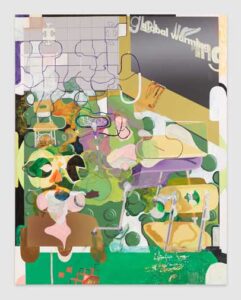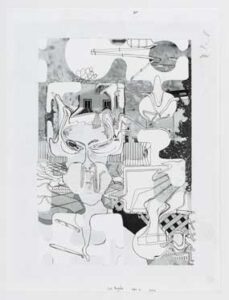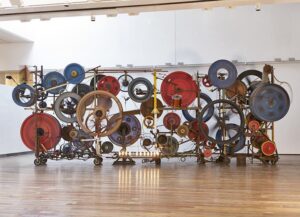
Michael Williams, “Purple Shebdy,” 2015, oil, airbrush, and inkjet on canvas, 108 x 85 in., Courtesy of the artist; CANADA, New York; Gladstone Gallery, New York and Brussels; and Galerie Eva Presenhuber, Zurich, © Michael Williams

Throughout the history of painting mimicry has been an ever present strategy, from sourcing the natural world to the mechanical properties of photography. Now trending is computer as muse: either as a tool for the process of painting, ink jet output as the painting, or a combination of both. For Michael Williams’ first solo museum exhibition in the United States at the Carnegie Museum of Art’s 78th Forum series, April 21 – August 27, 2017, it is both.
The exhibition includes large scaled paintings on the first floor gallery, and many smaller notebook sized mixed media pieces in a separate gallery on the second floor.
He works with a matrix of imagery: a lacrosse player, a school children’s chair, puzzle pieces, stylized shaped text, and an assortment of distorted faces and grid like passages. Some of the parts are reproduced from painting to painting via ink jet printing on canvas — others are replicated through hand painting, these components are then combined with abstracted painterly passages. Although the works appear to rely heavily on improvisation, once the notebook sized drawing collages are uncovered on the second floor (an adroit curatorial decision by Eric Crosby), the connection becomes clear that the super-sized paintings are derived from these small scale models.
In Purple Shebdy, 2015 oil, airbrush, and inkjet on canvas, 108” x 85”, the setting is a classroom – ‘Global Warming’ appears on a blackboard in the upper right corner of the painting, along with a tiled back wall with puzzle pieces, two school chairs, the lacrosse figure and also a distorted bust facing the viewer that looks like an abstracted Giuseppe Arcimboldo vegetable portrait. Filling out the rest of the painting are some abstracted impasto passages along with pipe like structures. The palette is comprised of a variety of greens, some yellows, tans, and a bit of lavender. In Brown Shape, oil and pencil on canvas, 114 ¼” x 77 “ there is a similar configuration of parts with repeats of the chairs, blackboard, in this case a stylized shaped text of ‘Global Warming’, puzzle parts, and another different distorted abstracted face near the bottom left quadrant of the painting.
In addition, there are hand-painted black bands at the top and bottom with an upside down mirrored CHASE logo hugging the bottom left corner. The preliminary model was literally made on the back of a CHASE bill and can be found in the second floor gallery.

Williams extends the language of gestural painting, bad painting, Pop art, and Neo-Expressionism in a post-postmodern mashup in these mundane narratives which are filled with abstracted, obfuscated imagery. The lack of commentary suggests a type of disengaged boredom and Truth about Painting 2, inkjet on canvas,128” x 84 ¾” one of two paintings in the exhibition comprised solely of ink jet printing is the most telling example. Here the central focus is a squeezed paint tube whose CVS pharmacy label is a prescription for Jenkem, a supposed mind altering drug made from human feces squirting out the text ‘the truth about painting’. Perhaps this reeks of another important part of Williams’ process and best expresses his conscientious apathy towards our current milieu.
Scott Turri
Scott Turri holds an MFA in Visual Art, West Virginia University and a BA, University of Pittsburgh
Volume 31 no.6 July / August 2017 p 34

